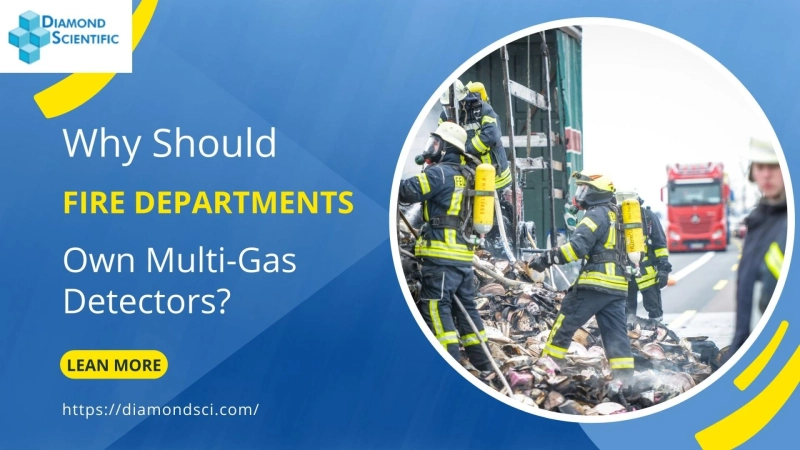Multi gas detectors are portable devices that are used to simultaneously detect numerous gases, as implied by their name. It is the final line of defence for warning operators of hazardous gas leaks. The risks associated with working with gas are well known to professionals in the fire fighting industry. They frequently come into contact with poisonous gases, which may be present at any stage of the fire. Any stage of a fire can produce toxic gases, but unless you utilise a multi-gas detector, you won't be able to tell for sure if the air in the cold zone is safe. As a result, an increasing number of firemen are realising that portable gas monitors are the straightforward solution to these problems and have incorporated these detectors into an essential component of their turnout equipment.
Why firefighters should use a multi-gas detector as essential gear?
Ideal for Detecting Gasses
Every day, fire departments respond to numerous calls about fatal gas leaks. Firefighters can use many gas detectors to find dangerous gases like carbon monoxide (CO). Additionally, they aid in locating the point of origin of such gas leaks. This gadget not only helps with carbon monoxide detection but also with dealing with gas leaks or other strange scents. Although carbon monoxide leak calls are frequent for firemen, there are occasionally other less well-known gas risks that also need to be watched. A good example of one of the most hazardous gases is hydrogen cyanide (HCN). Before, HCN was not a significant issue but has turned into a regular danger, more because synthetic materials have mostly replaced natural ones in the construction sector. When these substances are heated, they produce more HCN. For respiratory protection, the multi-gas monitor warns firefighters when HCN and other common chemical threats are present in the atmosphere.
Additionally, you may already be aware that experts require equipment to monitor the amount of water vapour, such as a led thermo hygrometer for restricted places. An additional requirement for firemen entering confined locations like storm drains or sewers is a multi-gas monitor. They can use it to determine whether the atmosphere in a small space is safe or not.
Ensures Team Safety
The majority of fire departments only have one multi-gas detector per apparatus or one for the entire department. It is preferable to have a multi-gas detector for every fireman, even though having one monitor per department is better than having none at all. Additionally, a central controller can simply monitor the scene and summon additional assistance if necessary thanks to the equipment's provision of real-time position and alert data. These elements will increase crew members' safety and increase their awareness of their surroundings. The remainder of the crew will receive alarms on their own multi-gas monitors if one crew member detects the presence of HCN or any other hazardous gas.
As a result, it will inform them of their atmospheric conditions and of any troublemakers. They will be able to start the rescue effort in the proper place with the use of this information.
Reliable & Durable
Gas detectors developed by the industry are built to withstand the worst environmental conditions. To protect them from prolonged immersion in water that is over three feet deep and full dust infiltration, manufacturers test them in harsh environments with an IP68 designation. Furthermore, trustworthy vendors and producers of these products offer a lifetime warranty. Thus, it is a fantastic long-term investment given its utility and robustness.
Fire departments are entitled to exercise caution when making equipment purchases, and gas monitors are no exception. It's crucial to pick gas detectors that can withstand time and keep up with your crew.
Maintenance is Simple
Multi-gas detectors can easily be seen as additional pieces of equipment that need maintenance. However, the truth is that with the proper instruments, modern gas monitors are simple to maintain. There are several ways to streamline or even automate maintenance so that your team can obtain the gas detection it needs without squandering critical time.
You may rely on the professionals to simplify routine maintenance by automatically bump testing and calibrating monitors in accordance with your schedule, saving you time from having to do it by hand. The gas monitors will be charged automatically each day, bump tested, and calibrated to your region's safety standards. Digital records of each of these activities are kept, allowing you to quickly obtain information and certificates.
Budget-Friendly
In relation to the level of security they offer, multi-gas monitors are reasonably priced. Despite the upfront expense, they guarantee the safety of each firefighter in your department for a number of years. In fact, a monitor more than pays for itself by averting just one workplace harm, making it simple to defend the spending. A gas detector exchange programme offers a financially sensible way for bigger fire departments with more than ten gas monitors to keep the fleet operational. This kind of service not only removes unforeseen costs but also provides your crew more time to concentrate on keeping your community safe by removing labour costs and inconveniences.
This read will surely help you you should understand why fire departments need multi-gas detecting equipment. These devices offer live gas measurements in addition to an optional pump module for pre-entry inspections. It is especially helpful in small, cramped situations where movement may be restricted. Although consumers can purchase a single gas detector, they should choose a multi-gas detector, particularly in the event of a fire.


